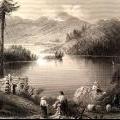 The early pioneers who came to the Eastern Townships from New England settled in a wilderness forest. They came with no assurance of their chances of survival, but with a determination to overcome all obstacles and build new lives for themselves.
The early pioneers who came to the Eastern Townships from New England settled in a wilderness forest. They came with no assurance of their chances of survival, but with a determination to overcome all obstacles and build new lives for themselves.
Once the idea of coming to the Townships was seriously considered, the first step was to open negotiations with an Agent in order to create a Company of Associates and obtain the grant of a section of land. The next step was to inspect the prospective land to see if it would be suitable. This trip north to Canada was usually made by a small number of men who followed a track or footpath through the wilderness, the trees having been marked by surveyors.
The men who made this trip had to be resourceful and completely self-sufficient, carrying only light provisions and prepared to hunt and fish for food along the way. Swarms of insects in June and July, which included the vicious biting "moose fly," hampered their journey. Once the group reached the area of their land claim, they checked for water sources and made the decision of whether or not to settle. If the decision was positive, they constructed a few primitive shelters so there would be shelter for their families when they all returned to the new land. After this was completed, they made the long trip back home.
The Family Journeys to the New Land:
The journey north was often undertaken in the winter, as travel through the woods was much easier at this time of year. The pioneers traveled on horseback or by ox-drawn wagons equipped with wooden sleds attached to the wheels to make crossing mud, ice or snow much easier.
The settlers had to bring enough equipment and provisions to last through the winter, spring, and summer months, until the first harvests came in. Money and supplies would be scarce, so the loading of provisions on the wagon was planned with great care. One hundred pounds of flour headed the list of items to be packed; then came the cooking utensils, consisting of a dutch oven usually made of iron to be used for baking, and an iron pot with a cover and three legs to be used over an open fire. Molds for making candles would furnish the only source of light. Bedding, a spinning wheel, and a small loom were essential, as well.
The men would carry guns, gunpowder, and flint to hunt for food and to protect their families from predators. The axe would be their means of building a shelter and providing firewood. They also packed saws, augers, adzes, and planes.
Livestock, such as a cow, laying hens, a sow, and some sheep, often made the trip with the pioneer family. (Sheep wool would be used on the spinning wheel and loom). Seeds for spring planting and grain were also brought.
Wooden buckets to carry water and milk were essential to their travels. Some families brought a little china to cherish and small panes of glass for their new home. Wooden bowls and spoons were used for eating, and more would be made as required. Another important item was the family Bible, in which records of births and deaths would be carefully entered.